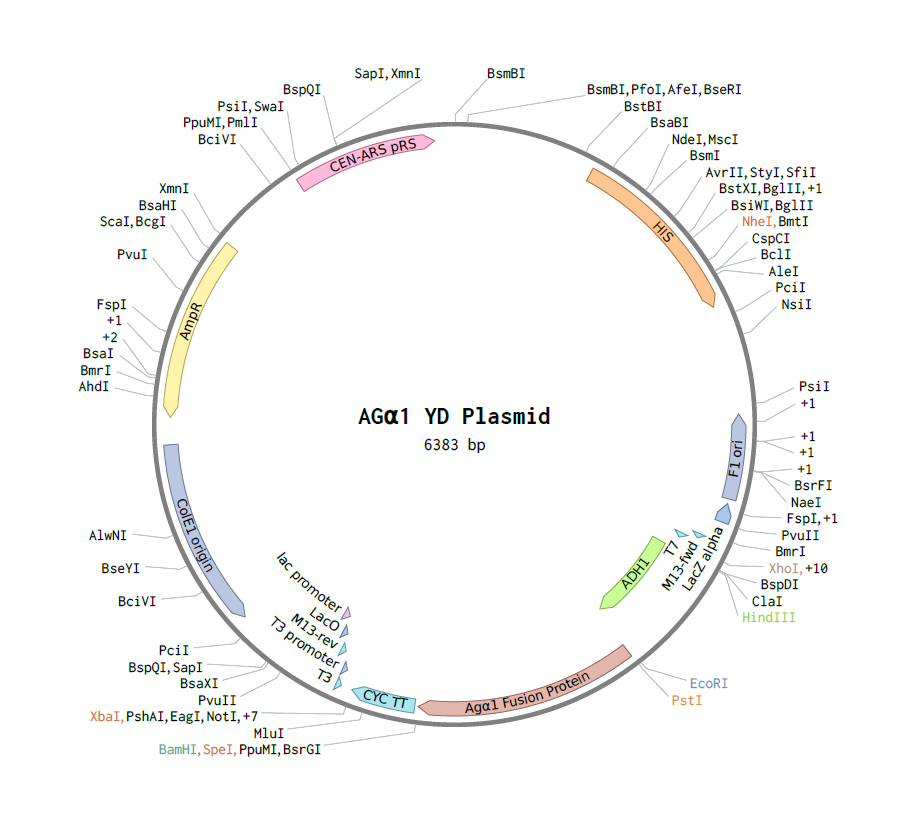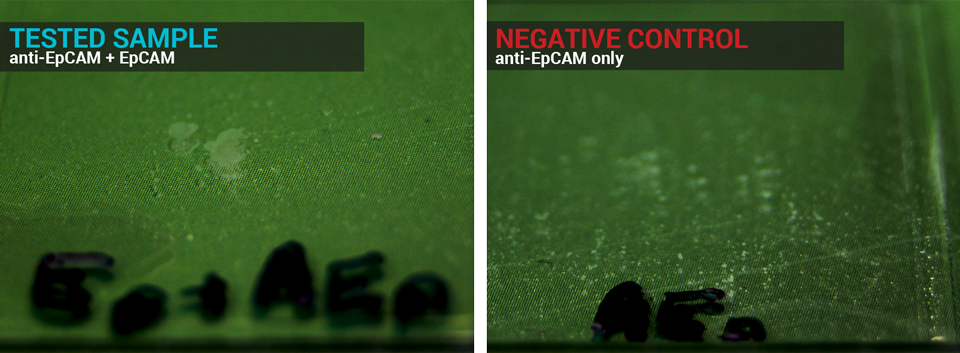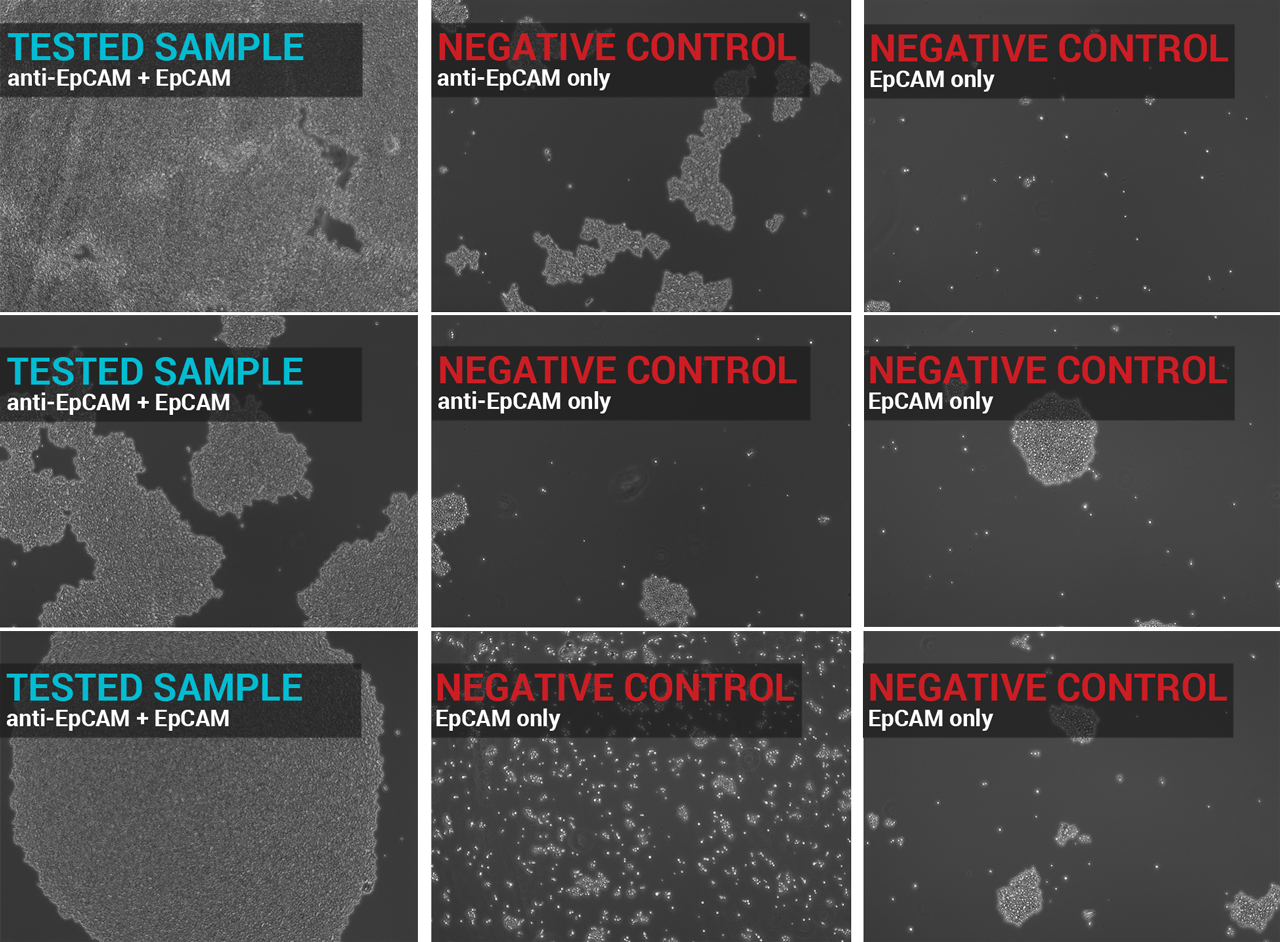Difference between revisions of "Team:Czech Republic/Project/Location tags"
(→Interactions of EpCAM and Anti-Ep CAM scFv) |
(→Key Achievements) |
||
| Line 6: | Line 6: | ||
== Key Achievements == | == Key Achievements == | ||
| − | * Expressed streptavidin, EpCAM, Anti-EpCAM scFv, c-Myc scFv and anti-HuA scFv on the surface of yeasts | + | * Expressed streptavidin, EpCAM, Anti-EpCAM scFv, c-Myc scFv and anti-HuA scFv on the surface of yeasts |
| − | * Monitored the dynamic binding of the displayed fragments of antibodies and corresponding markers | + | * Monitored the dynamic binding of the displayed fragments of antibodies and corresponding markers |
| − | * Demonstrated compatibility of our yeast system and blood and functionality of the location tags in plasma | + | * Demonstrated compatibility of our yeast system and blood and functionality of the location tags in plasma |
<html></div><div class="break"></div></div></html> | <html></div><div class="break"></div></div></html> | ||
Revision as of 20:55, 18 September 2015
Location Tags
Contents
Abstract
To guarantee the ability of our system to recognize, bind, and respond to the presence of a tumour cell, we selected five antibody fragments to display on our yeast cells using the yeast display technology and monitor the cells' binding. Their expression was detected and monitored on a microfluidic chip and was also visualized with the use of antibody staining and fluorescence microscopy.
Key Achievements
- Expressed streptavidin, EpCAM, Anti-EpCAM scFv, c-Myc scFv and anti-HuA scFv on the surface of yeasts
- Monitored the dynamic binding of the displayed fragments of antibodies and corresponding markers
- Demonstrated compatibility of our yeast system and blood and functionality of the location tags in plasma
Introduction
To enable our modified Saccharomyces cerevisiae cells to bind extracellular markers, we expressed single-chain variable fragments of antibodies (scFvs) on their surface. These proteins are fused with the adhesion subunit of a-agglutinin, which is a protein naturally used by S. cerevisiae for aggregation during mating. Binding of the antibody to its specific marker enables full development of a signal transduction dependent on the pheromone signaling pathway. We proposed a modified yeast display technique to enable our cells to present the antibody fragments on their surface at all times. We were able to detect and measure the binding of several oncogenic, epithelial, and blood markers.
Agglutinins
Alpha-agglutinin and a-agglutinin are cell wall glycoproteins of S. cerevisiae that possess complementary surfaces and mediate cell-to-cell adhesion during mating [Lipke and Kurjan, 1992]. A-agglutinin consists of two subunits, of which Aga1p is anchored to the membrane by a glycosylphosphatidylinositol anchor (GPI) and to which the second subunit, Aga2p, is bound by two disulphide bonds. Alpha-agglutinin is composed of only one subunit and is connected to a modified GPI anchor. They are both highly glycosylated and constitutively expressed in low levels [Zhao et al, 2001].
Yeast Display
The Yeast Surface Display was first described in 1997 by E. Border and K. Wittrup as a method for engineering cell surface and secretion proteins. It provides a great advantage of the possibility of post-translational modifications in a eukaryotic organism - yeast. One of the most widespread uses of Yeas Display is screening polypeptide libraries for high-affinity antibodies[Boder and Wittrup, 1997].
Design
Traditional Yeast Display
The gene for the protein of interest to be displayed on a cell's surface is fused in frame to the AGA2 gene on a yeast display plasmid. The second part of the display, AGA1 gene is integrated into a chromosome in a special S. cerevisiae strain EBY100. Both of the constructs are originally under a GAL1 promoter, thus requiring galactose to be present in the medium for the system to function. [Baird et al, 2012].
We obtained the original yeast display system from professor Sheldon Park, which we are thankful for. This particular yeast display plasmid used the BamHI and NheI restriction sites for insertion of scFv sequences and possessed a hemagglutinin tag upstream of the scFv sequence insertion site and a FLAG epitope at the downstream end.
Choice of Markers
To develop and test our system we chose to express on the surface of our S. cerevisiae cells the following markers.
Biotin
Biotin was our first choice of a marker because of its extremely strong bond with streptavidin. It could give us not only great results but also a benchmark affinity value to compare the other antibodies’ affinities to.
EpCAM
EpCAM, the transmembrane epithelial cell adhesion molecule, functions in cell signaling, proliferation, differentiation, and is present in many carcinomas. We selected it because of its significance in tumor growth promotion and its ability to bind Anti-EpCAM, which we also expressed on S. cerevisiae using yeast display.
c-Myc
C-Myc is a transcription factor that regulates cell growth, apoptosis, and cellular differentiation. Its levels are often upregulated in different cancer types, where it plays a role in gene duplication and Ras interaction.
HuA
HuA stands for human antigen A of red blood cells. The decision to enable the expression of an antibody against antigen A on yeast surface allows us to test our system directly in blood and prove that the positive agglutination reaction is specific and clearly visible.
Modified Yeast Display
Furthermore, we made several modifications to the yeast display method in order for it to better suit our needs. The goal was to simplify it and reduce the amount of new DNA that needs to be introduced into a yeast cell. The first of two alternatives was based on creating a general cassette containing a promoter, a terminator, and necessary cloning sites. The second alternative meant attaching the specific antibody with a terminal epitope tag directly to Agα1 protein.
Expression Cassette
We wanted to build five variations of the pRSII 413 plasmid based on which final cassette will act as the insert. The design of our cassette included using the constitutive pTv3 promoter, and a terminator sequence. One of the five final cassettes would contain the sequence coding for the Aga1 protein, and four of the cassette inserts would contain sequences coding for Aga2 protein fused with a single chain antibody of choice. By carefully designed consequent PCR reactions and restriction digests we aimed to obtain in vitro the 1) promoter, 2) terminator, 3) promoter and terminator, 4) promoter, ORF and terminator. Subsequent restriction digests and ligations would lead to a complete expression plasmid containing our desired inserts.
Agα1p version
By fusing the antibody fragment directly to the Agα1 protein, we are able to eliminate the complications that arise because of the translation of several proteins in a row. The courage to pursue this alternative stemmed from the positive results obtained by J. Wasilenko and colleagues in their work of displaying the hemagglutinin of avian influenza virus on yeast cells using alpha-agglutinin. We aimed to incorporate into only one plasmid the sequence for an antibody fused with the C-terminal end of Agalpha1 (alpha-agglutinin) and a secretion signal. All of it to be controlled by one promoter [Wasilenko et al, 2010]. See Figure 3.2 for a schematic of the plasmid enabling yeasts to express an antibody on its surface using only the Agα1 protein.
Construction
Construction of the Traditional Yeast Display Plasmids
We used modified pCT302 plasmid (https://www.addgene.org/41845/) and inserts described below for the construction of our final yeast display plasmids. Strain EBY100 was used for yeast display experiments. Expression of the protein display on the yeast surface can be readily induced by addition of galactose to the growing medium.
More information about sequences used in yeast display experiments:
Streptavidin
The gene encoding streptavidin protein is 381 bps long. Sequences containing priming sites for M13 forward and reverse primers were added at the ends of the synthesized streptavidin so that streptavidin gene could be amplified with these commonly used primers. Cutting sites for BamHI and NheI restriction endonucleases were also added for easy cloning into the yeast display plasmid.
ATGGCTGAAGCTGGTATCACCGGCACCTGGTACAACCAGCTGGGTTCCACCTTCATCGTTACCGCTGGTGCTGACGGTGCTCTGACCGGTACCTACGAATCCGCTGTTGGTAACGCTGAAAGCCGCTACGTTCTGACCGGTCGTTACGACTCCGCTCCGGCTACCGACGGTTCCGGAACCGCTCTGGGTTGGACCGTTGCTTGGAAAAACAACTACCGTAACGCTCACTCCGCTACCACCTGGTCTGGCCAGTACGTTGGTGGTGCTGAAGCTCGTATCAACACCCAGTGGTTGTTGACCTCCGGCACCACCGAAGCCAACGCGTGGAAATCCACCCTGGTTGGTCACGACACCTTCACCAAAGTTAAACCGTCCGCTGCTTCTTAA
Sequence was extracted from the iGEM parts database and further optimized for expression in yeast (http://parts.igem.org/Part:BBa_K283010).
EpCAM
EpCAM protein consists of 314 amino acids. We used the sequence encoding only the extracellular part of the EpCAM protein (729 bps long). We also added restriction sites for BamHI, NheI (yeast display) and SpeI, EcoRI (EpCAM production) endonucleases with PCRs.
ATGCAAGAAGAATGTGTATGTGAAAATTATAAACTAGCTGTCAACTGTTTTGTAAATAACAATAGACAGTGTCAATGTACTTCCGTTGGCGCTCAAAACACAGTTATCTGTTCTAAACTAGCCGCGAAGTGTCTTGTTATGAAGGCAGAGATGAATGGCTCCAAACTGGGTAGGCGTGCCAAGCCTGAGGGTGCCCTACAGAACAATGATGGGCTTTACGATCCAGATTGTGATGAATCCGGTTTATTCAAAGCCAAGCAGTGTAATGGTACTTCCATGTGCTGGTGTGTAAACACCGCTGGAGTGAGGAGAACCGATAAAGACACGGAAATCACCTGTAGCGAAAGAGTCAGGACTTACTGGATCATTATCGAACTGAAGCACAAAGCTAGGGAGAAGCCTTATGACAGCAAAAGTTTGAGGACTGCCTTACAGAAAGAAATCACAACTAGGTATCAATTAGACCCGAAATTTATAACGAGTATCCTTTACGAGAATAACGTCATTACCATTGATCTAGTGCAAAATTCTTCCCAGAAGACTCAAAATGACGTTGATATTGCAGATGTTGCCTATTACTTTGAAAAAGATGTGAAAGGAGAGAGTTTGTTCCACTCAAAAAAGATGGATCTGACAGTTAACGGGGAACAGTTAGATCTTGATCCGGGTCAAACGTTAATATATTATGTTGACGAAAAAGCACCAGAATTTAGTATGCAGGGATTGAAATAA
The sequence was extracted from the Uniprot database and further optimized for expression in yeast (http://www.uniprot.org/uniprot/P16422).
Anti-EpCAM
This sequence encodes part of the C215 Anti-EpCAM antibody (scFv) and is 756 bps long. It consists of sequences encoding light and heavy chains of the antibody. These sequences are connected through a G4S linker. Restriction sites recognized by BamHI and NheI were added for easy cloning into the yeast display plasmid.
ATGCAGGTCAAGCTtCAGCAGTCAGGGGCTGAACTGGTGAGGCCTGGGGCTTCAGTGAAGCTGTCCTGCAAGGCTTCTGGCTACACCTTCACCAACTACTGGATAAACTGGGTGAAGCAGAGGCCTGGACAAGGCCTTGAGTGGATCGGAAATATTTATCCTTCTTATATTTATACTAACTACAATCAAGAGTTCAAGGACAAGGTCACATTGACTGTAGACGAATCCTCCAGCACAGCCTACATGCAGCTCAGCAGCCCGACATCTGAGGACTCTGCGGTCTATTACTGTACAAGATCCCCTTATGGTTACGACGAGTATGGTCTGGACTACTGGGGCCAAGGCACCACGGTCACCGTCTCCTCAGGTGGAGGCGGTTCAGGCGGAGGTGGCTCTGGCGGTGGCGGATCGGACATCGAGCTCACTCAGTCTCCATCCTCCCTGACTGTGACAGCAGGAGAGAAGGTCACTATGAACTGCAAGTCCAGTCAGAGTCTGTTAAACAGTAGAAATCAAAAGAACTACTTGACCTGGTACCAGCAGAAACCAGGGCAGCCTCCTAAACTGTTGATATACTGGGCATCCACTAGGGAATCTGGGGTCCCTGATCGCTTCACAGGCAGTGGATCTGGAACAGATTTCACTCTCACCATCAGCAGTGTGCAGGCTGAAGACCTGGCAGTTTATTACTGTCAGAATGATTATGTTTATCCGCTCACGTTCGGTGCTGGGACCAAGCTGGAAATAAAACGGTAA
The sequence was extracted from the European Nucleotide Archive database and further optimized for expression in yeast (http://www.ebi.ac.uk/ena/data/view/AJ564232).
Anti-c-Myc (9E10)
This sequence encodes part of the 9E10 Anti-cMyc antibody (scFv) and is 780 bps long. It consists of sequences encoding light and heavy chains of the antibody. These sequences are connected by a Yol linker containing a Yol epitope. Restriction sites recognized by BamHI and NheI were added for easy cloning into the yeast display plasmid.
ATGCAGGTGCAGCTaCAGGAGTCTGGGGGAGACTTAGTGAAGCCTGGAGGGTCCCTGAAACTCTCCTGTGCAGCCTCTGGATTCACTTTCAGTCACTATGGCATGTCTTGGGTTCGCCAGACTCCAGACAAGAGGCTGGAGTGGGTCGCAACCATTGGTAGTCGTGGTACTTACACCCACTATCCAGACAGTGTGAAGGGACGATTCACCATCTCCAGAGACAATGACAAGAACGCCCTGTACCTGCAAATGAACAGTCTGAAGTCTGAAGACACAGCCATGTATTACTGTGCAAGAAGAAGTGAATTTTATTACTACGGTAATACCTACTATTACTCTGCTATGGACTACTGGGGTCAAGGAGCCTCAGTCACCGTCTCCTCAGCCAAAACAACACCCAAGCTTGAAGAAGGTGAATTTTCAGAAGCACGCGTAGATATCGTTCTCACTCAATCTCCAGCTTTCTTGGCTGTATCTCTAGGACAGAGGGCCACCATCTCCTGtAGAGCCAGCGAAAGTGTTGATAATTATGGCTTTAGTTTTATGAACTGGTTCCAACAGAAACCAGGACAGCCACCCAAACTCCTCATCTATGCTATATCCAACCGAggttctGGGGTCCCTGCCAGGTTTAGTGGCAGTGGGTCTGGGACAGACTTCAGCCTCAACATCCATCCTGTAGAGGAGGATGATCCTGCAATGTATTTCTGTCAGCAAACTAAGGAGGTTCCGTGGACGTTCGGTGGAGGCACCAAGCTGGAAATCAAACGGGCTGTTGCTTAA
The sequence was extracted from the article "Primary structure and functional scFv antibody expression of an antibody against the human protooncogene c-myc." and further optimized for expression in yeast (http://www.ncbi.nlm.nih.gov/pubmed/9219032).
Anti-HuA
This sequence encodes part of the AC-1001 Anti-HuA (Human antigen A) antibody (scFv) and is 735 bps long. It consists of sequences encoding light and heavy chains of the antibody. These sequences are connected by a G4S linker. Restriction sites recognized by BamHI and NheI were added for easy cloning into the yeast display plasmid.
ATGCAAGTCCATTTAGTGGAGTCAGGTGGTGGCGTAGTTCAACCTGGAAGATCATTGACACTTTCCTGTGCTGCGTCCGGTTTTACCTTCAATTCTTATACGTTCCACTGGGTAAGACAAACCCCAGGTAAAGGTCTTGAATGGGTTGCAGTTTTAGCATACGACGGGAGTTACCAGCATTATGCAGATTCCGTGAAAGGAAGATTTACAATTTCCAGAGATAACAGCAAAAATACTTTATACTTGCAAATGAATAGTCTGAGACTTGAAGACACAGCGGTATACTTCTGTGCAAGGGGACAGACTACAGTTACTAAAATTGATGAGGACTATTGGGGGCAGGGTACATTGGTAATTGTCTCCTCCGGTGGTGGCGGTAGTGGAGGCGGTGGCTCCGGGGGAGGGGGCTCTGAGATCGTCCTTACCCAGTCTCCAGCAACGCTTAGTTTGTCTCCTGGAGAAAGAGCTACACTTTCTTGCAGAGCAAGCCAGTCTGTCTCTTCTTACTTAGCTTGGTATCAGCAAAAACCAGGTCAGGCTCCAAGGTTGCTGATATATGATGCATCTAACAGGGCGACTGGTATTCCTGCCAGGTTTTCCGGCTCCGGTTCTGGCACTGACTTCACACTTACTATTTCATCTCTAGAACCAGAAGATTTTGCCGTTTATTACTGCCAGCAGAGATCTAATTGGCCTAGGTCTTTTGGTCAGGGTACGAAGGTCGAGATCAAAAGGTAA
The sequence was extracted from the article "Human and mouse monoclonal antibodies to blood group A substance, which are nearly identical immunochemically, use radically different primary sequences." and further optimized for expression in yeast (http://www.ncbi.nlm.nih.gov/pubmed/7759488).
Construction of the Expression Cassette
Sequence of the Aga1 protein was amplified from yeast genome using Q5 polymerase and sequences of the pTv3 promoter and CYC terminator was amplified from plasmids provided by Module 1 (working on synthetic haploids). The primers we used are disclosed in the table below.
| Name | Sequence |
|---|---|
| pTv3 down | TTAACAGAATTCGGATTCTCACAATCCTGTCGGT |
| pTv3 up | ATAATTCTCGAGAAGCTTGGACTTCCCACCGCCTTC |
| CYC TT down | ACAAAAGTCGACTCTAGACGAGCGTCCCAAAACCT |
| CYC TT up | ATATTAGAATTCATTATTAAATGGATCCTCATGTAATTAGTTATGTCACGCT |
| Aga1 down | ATATATGGATCCTTAACTGAAAATTACATTGCAAGCA |
| Aga1 up | ATATTAGAATTCACCACCATGACATTATCTTTCGCTCATTTTAC |
The amplification of Aga1 and assembly of the promoter and the terminator in one sequence was successful as proved by gel electrophoresis and subsequent gel purification. However, even after many repeated tries to clone the premature cassette into the pRS413 and pRS415 plasmids, our efforts remained futile. We tried using different ligases, amount of electroporated cells, and even a different cloning vector. As a result, we turned our focus solely on testing and improving the first of the three approaches - the original yeast display system.
Construction of Yeast Display Using only One Plasmid
This alternative greatly appealed to us thanks to its elegance and simplicity, but proved to be quite time-consuming to prepare. Therefore we only finished the design of the system that can be seen in Figure 3.4 below and assigned the idea only for future experiments.
Materials and Methods
Strains
E. coli
- DH5α
S. cerevisiae
- EBY100
- BY4741
- 7284 MATa
Materials
- LB-M agar plates with ampicillin
- 1.5 ml eppendorf tubes
- 0.5 ml PCR tubes
- 50 ml centrifuge tubes
- NucleoSpin Plasmid DNA, RNA, and protein purification Kit
- NucleoSpin Gel and PCR Clean-up Kit
- LB-M medium with chloramphenicol
- YPD medium
- SD-min medium + CAA
- NaOH agarose gel and buffer
- TAE agarose gel and buffer
Methods
- Transformation
- Minipreparation of plasmid DNA
- Restriction digest
- Ligation
- NucleoSpin gel clean-up
- NucleoSpin plasmid DNA purification
- Induction of protein display
- Fluorescent immunostaining
Detailed description of all methods can be found on our Protocols page.
Results
Microscopy
Immunofluorescent labeling of displayed proteins
Successful display of our proteins was confirmed by immunofluorescent staining. Yeast display plasmid enables labeling by anti-HA and anti-FLAG antibodies. We have stained our modified yeast strains with both of these antibodies. Presence of the fused proteins on the surface can be distinguished by visible "glowing corona".
Interactions of EpCAM and Anti-Ep CAM scFv
Interaction of the cancer marker EpCAM and Anti-EpCAM scFv was hard to
Microfluidics
Yeast-induced blood agglutination on chip
The master experiment
References
- ↑ Zhao, H.,Shen, Z.-M., Kahn, P. C. and Lipke, P. N. (2001). Interaction of α-Agglutinin and a-Agglutinin, Saccharomyces cerevisiae Sexual Cell Adhesion Molecules. Journal of Bacteriology, 183(9), 2874–2880. doi:10.1128/JB.183.9.2874-2880.2001
- ↑ Lipke, P. N. and Kurjan, J. (1992). Sexual agglutination in budding yeasts: structure, function, and regulation of adhesion glycoproteins. Microbiology and Molecular Biology Reviews, 56(1), 180-194.
- ↑ Boder, E. T. and Wittrup, K. D. (1997). Yeast surface display for screening combinatorial polypeptide libraries. Nature Biotechnology, 15, 553-557. doi:10.1038/nbt0697-553
- ↑ Baird, C. et al. (2012). Yeast Display scFv Antibody Library User’s Manual. Richland, WA: Pacific Northwest National Laboratory.
- ↑ Wasilenko, J. L. et al. (2010). Cell Surface Display of Highly Pathogenic Avian Influenza Virus Hemagglutinin on the Surface of Pichia Pastoris Cells Using alpha-Agglutinin for Production of Oral Vaccines. Biotechnology Progress, 26(2), 542-547. doi:10.1002/btpr.343.



